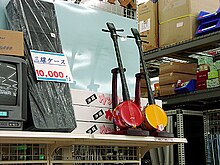Kankara sanshin

Thekankara(かんから)orkankara sanshin(literally "sanshinfrom a can ") is aJapanesethree-stringedfolkplucked instrument,initially an improvised derivative of the Okinawansanshinthat was developed in theRyukyu Islandsduring theShōwa period.
Like the wooden-bodiedgottan,thekankarais an inexpensive alternative to other, professional Japaneselutes– namely thesanshinand the similar, albeit largershamisen.Unlike thegottan,however, thekankarawas invented much later and served a much different purpose historically.
History[edit]
Thekankara sanshinoriginates in the period following the World War IIBattle of Okinawa.Okinawans, including men detained by the American military, made use of metal cans discarded by the Americans, and used them as the body for improvisedsanshin.[1]
A similar type of can-basedsanshinwas made by Japanese-Americansin internment camps in the United Statesduring the war.[2]
Since World War II,kankarahave become popular as inexpensive alternatives to thesanshinorshamisen,and professionalsanshinorshamisenmakers have begun to craft them and include them in their stores, online and in catalogues. Thekankaraitself has also evolved to some degree, with certain makers creating more ornate instruments with hand-painted frontal designs and the decorative wrappingstiigaa(Thủ quải)that are a feature of thesanshinproper.DIY"build-your-own"kankara sanshinkits are also readily available.
Construction and components[edit]
The following is a list of basic components that normally make up akankara sanshin,with Japanese phrases that refer to the English terms insanshinandshamisenparlance:
- Body(Đỗng,chiiga/dou)— An empty metal can or cylinder is used to create the body of the instrument, in lieu of thesnakeskin-covered bodies typical ofsanshin.
- Headstock(Thiên,ten)— The headstock of the instrument is made in an unspecified way, usually resembling that of asanshinorshamisen.It is normally an extension of the neck.
- Neck(Trạo,sou)— The long neck of the instrument is constructed from any one of an assortment of different types of wood.[a]
- Strings(Huyền,chiru/gen/jiru)— Thekankara,normally being a less costly instrument than asanshinproper, may have its strings made from any of a variety of materials. There is no normative material used for stringing. Nylon, sinew, metal wire and other materials may be used, depending upon the maker.[b]
- Tuning pegs(Phạm,karakui)— The tuning pegs/knobs/keys used for thekankaraare made in an unspecified way, sometimes resembling the long pegs characteristic of thesanshinandshamisen,and at other times more akin to those found on modern and classical guitars.
Notes[edit]
References[edit]
- ^Eiji Oguma(1 April 2014).The Boundaries of "The Japanese": Okinawa 1818-1972 Inclusion and Exclusion.Trans Pacific Press. pp. 358–.ISBN978-1-920901-48-6.
- ^Ronald Y. Nakasone (1 January 2002).Okinawan Diaspora.University of Hawaii Press. pp. 105–.ISBN978-0-8248-2530-0.
See also[edit]
Further reading[edit]
- Kōshichi Taira (1982).Kankara sanshin: Taira Kōshichi no mita sengo Okinawa 20-nen no kiroku.Saníchi Shobō.
